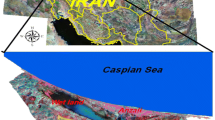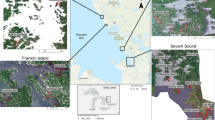Abstract
Accurate wetland delineation is the basis of wetland definition and mapping, and is of great importance for wetland management and research. The Zoigê Plateau on the Qinghai-Tibet Plateau was used as a research site for research on alpine wetland delineation. Several studies have analyzed the spatiotemporal pattern and dynamics of these alpine wetlands, but none have addressed the issues of wetland boundaries. The objective of this work was to discriminate the upper boundaries of alpine wetlands by coupling ecological methods and satellite observations. The combination of Landsat 8 images and supervised classification was an effective method for rapid identification of alpine wetlands in the Zoigê Plateau. Wet meadow was relatively stable compared with hydric soils and wetland hydrology and could be used as a primary indicator for discriminating the upper boundaries of alpine wetlands. A slope of less than 4.5° could be used as the threshold value for wetland delineation. The normalized difference vegetation index (NDVI) in 434 field sites showed that a threshold value of 0.3 could distinguish grasslands from emergent marsh and wet meadow in September. The median normalized difference water index (NDWI) of emergent marsh remained more stable than that of wet meadow and grasslands during the period from September until July of the following year. The index of mean density in wet meadow zones was higher than the emergent and upland zones. Over twice the number of species occurred in the wet meadow zone compared with the emergent zone, and close to the value of upland zone. Alpine wetlands in the three reserves in 2014 covered 1175.19 km2 with a classification accuracy of 75.6%. The combination of ecological methods and remote sensing technology will play an important role in wetland delineation at medium and small scales. The correct differentiation between wet meadow and grasslands is the key to improving the accuracy of future wetland delineation.
Similar content being viewed by others
References
Amler E, Schmidt M, Menz G, 2015. Definitions and mapping of East African wetlands: a review. Remote Sensing, 7(5): 5256–5282. doi: 10.3390/ rs70505256
Bai J H, Lu Q Q, Wang J J et al., 2013. Landscape pattern evolution processes of alpine wetlands and their driving factors in the Zoigê Plateau of China. Journal of Mountain Science, 10(1): 54–67. doi: 10.1007/s11629-013-2572-1
Berkowitz J F, 2011. Recent advances in wetland delineationimplications and impact of regionalization. Wetlands, 31(3): 593–601. doi: 10.1007/s13157-011-0167-6
Cordeiro C L O, Rossetti D F, 2015. Mapping vegetation in a late Quaternary landform of the Amazonian wetlands using object-based image analysis and decision tree classification. International Journal of Remote Sensing, 36(13): 3397–3422. doi: 10.1080/01431161.2015.1060644
Chen Zhike, Lu Xianguo, 2010. Comparison between the marsh wetland landscape patterns in the Zoigê Plateau for two periods. Wetland Science, 8(1): 8–14. (in Chinese)
Clinton N, Holt A, Scarborough J et al., 2010. Accuracy assessment measures for object-based image segmentation goodness. Photogrammetric Engineering & Remote Sensing, 76(3): 289–299. doi: 10.14358/PERS.76.3.289
Davidson N C, 2014. How much wetland has the world lost? Long-term and recent trends in global wetland area. Marine and Freshwater Research, 65(10): 934–941. doi: 10.1071/MF14173
Deng Maolin, Tian Kun, Duan Zongliang et al., 2010. The changes of landscape at Zoigê Plateau wetland reserve in Sichuan, China. Journal of Mountain Science, 28(2): 240–246. (in Chinese)
Dronova I, Gong P, Wang L et al., 2011. Object-based analysis and change detection of major wetland cover types and their classification uncertainty during the low water period at Poyang Lake, China. Remote Sensing of Environment, 115(12): 3220–3236. doi: 10.1016/j.rse.2011.07.006
Environmental Laboratory, 1987. Corps of Engineers Wetlands Delineation Manual. Wetlands Research Program Technical Report (on-line edition) of US Army Corps of Engineers Waterways Experment Station. Available at: http://el.erdc.usace.army.mil/elpubs/pdf/wlman87.pdf. Cited 13 Feb 2017
Feyisa G L, Meilby H, Fensholt Ret al., 2014. Automated water extraction index: a new technique for surface water mapping using Landsat imagery. Remote Sensing of Environment, 140(1): 23–25. doi: 10.1016/j.rse.2013.08.029
Frohn R C, Reif M, Lane C et al., 2009. Satellite remote sensing of isolated wetlands using object-oriented classification of Landsat-7 data. Wetlands, 29(1): 931–941. doi: 10.1672/08-194.1
Ge Dexiang, Li Chong, Wang Yicheng et al., 2007. Area change of Hui he wetland and the relation between that and local climate from 2000 to 2007. Wetland Science, 7(4): 314–320. (in Chinese)
Guo X Y, Zhang H Y, Yuan T et al., 2015. Detecting the temporal scaling behavior of the normalized difference vegetation index time series in China using a detrended fluctuation analysis. Remote Sensing, 7(10): 12942–12960. doi: 10.3390/rs71012942
Hassan N, Hamid J R A, Adnan N A et al., 2014. Delineation of wetland areas from high resolution WorldView-2 data by object-based method. 8th International Symposium of the Digital Earth (Isde8). IOP Conference Series: Earth and Environmental Science, 18: 012017. doi: 10.1088/1755-1315/18/1/012017
Junk W J, Piedade M T F, Lourival R et al., 2014. Brazilian wetlands: their definition, delineation, and classification for research, sustainable management, and protection. Aquatic Conservation: Marine and Freshwater Ecosystems, 24(1): 5–22. doi: 10.1002 /aqc.2386
Kang X M, HaoY B, Cui XY et al., 2016. Variability and changes in climate, phenology, and gross primary production of an alpine wetland ecosystem. Remote Sensing, 8(5): 391. doi: 10.3390 /rs8050391
Kumar L, Sinha P, Taylor S, 2014. Improving image classification in a complex wetland ecosystem through image fusion techniques. Journal of Applied Remote Sensing, 8(1): 083616. doi: 10.1117/1.JRS.8.083616
Lee H, Yuan T, Jung H C et al., 2015. Mapping wetland water depths over the central Congo Basin using PALSAR Scan-SAR, Envisat altimetry, and MODIS VCF data. Remote Sensing of Environment, 159(1): 70–79. doi: 10.1016/j.rse.2014.11.030
Li Ke, Yang Yongxing, Yang Yang et al., 2011. Characteristics and influence factors of the swamp degradation under the stress of grazing in the Zoigê Plateau. Acta Ecologica Sinica, 31(20): 5956–5969. (in Chinese)
Lillesand T, Kiefer R, Chipman J, 2004. Remote sensing and image interpretation (Fifth Edition). New Jersey: John Wiley & Sons, Inc.
Martinez-Lopez J, Carreno M F, Palazon-Ferrando J A et al., 2014. Free advanced modeling and remote-sensing techniques for wetland watershed delineation and monitoring. International Journal of Geographical Information Science, 28(8): 1610–1625. doi: 10.1080/13658816.2013.852677
McFeeters S K, 1996. The use of the normalized difference water index (NDWI) in the delineation of open water features. International Journal of Remote Sensing, 17(7): 1425–1432
Mitsch W J, Gosselink J G, 2007. Wetlands. New York: John Wiley & Sons, Inc.
Mustapha M R, Lim H S, Mat Jafri M Z, 2010. Comparison of neural network and maximum likelihood approaches in image classification. Journal of Applied Sciences, 10(22): 2847–2854. doi: 10.3923/jas.2010. 2847.2854
Pearsell G, Mulamoottil G, 1994. Wetland boundary and land-use planning in southern Ontario, Canada. Environment Management, 18(6): 865–870. doi: 10.1007/BF02393616
Quinn N W T, Epshtein O, 2014. Seasonally-managed wetland footprint delineation using Landsat ETM plus satellite imagery. Environmental Modelling & Software, 54(4): 9–23. doi: 10.1016/j. envsoft.2013.12.012
Thomas R F, Kingsford R T, Lu Y et al., 2015. Mapping inundation in the heterogeneous floodplain wetlands of the Macquarie Marshes, using Landsat Thematic Mapper. Journal of Hydrology, 524(2): 194–213. doi: 10.1016/j.jhydrol.2015. 02.029
Tiner R W, 1999. Wetland Indicators: A Guide to Wetland Identification, Delineation, Classification, and Mapping. Boca Raton, FL: CRC Press.
Tiner R W, 2006. Lists of potential hydrophytes for the United States: a regional review and their use in wetland identification. Wetlands, 26(2): 624–634. doi: 10.1672/0277-5212
Tucker C J, 1979. Red and photographic infrared linear combinations for monitoring vegetation. Remote Sensing Environment, 8(2): 127–150. doi: 10.1016/0034-4257(79)90013-0
Wilson M J, Bayley S E, 2012. Use of single versus multiple biotic communities as indicators of biological integrity in northern prairie wetlands. Ecological Indicators, 20(2): 187–195. doi: 10.10 16/j.ecolind.2012.02.009
Wilson M J, Bayley S E, Rooney R C, 2013. A plant-based index of biological integrity in permanent marsh wetlands yields consistent scores in dry and wet years. Aquatic Conservation: Marine and Freshwater Ecosystems, 23(5): 698–709. doi: 10.1002/aqc.2354
Wilson E H, Sader S A, 2002. Detection of forest harvest type using multiple dates of Landsat TM imagery. Remote Sensing of Environment, 80(3): 385–396. doi: 10.1016/S0034-4257(01)00318-2
Woodward C, Shulmeister J, Larsen J et al., 2014. The hydrological legacy of deforestation on global wetlands. Science, 346(6211): 844–847. doi: 10.11 26/science.1260510
Wu Meiyin, Kalma D, Treadwell-Steitz C, 2014. Differential assessment of designations of wetland status using two delineation methods. Environment Management, 54(1): 23–29. doi: 10.1007/s00267-014-0273-3
Xue Z S, Zhang Z S, Lu X G et al., 2014. Predicted areas of potential distributions of alpine wetlands under different scenarios in the Qinghai-Tibetan Plateau, China. Global and Planetary Change, 123(10): 77–85. doi: 10.1016/j.gloplacha.2014. 10.012
Ye Yu, Liu Gaohuan, Huang Chong et al., 2011. Analysis on relationship between wetland landscape and environmental factors in Zoigê Plateau based on DCCA. Geo-information Science, 13(3): 313–322. (in Chinese)
Zheng Y M, Zhang H Y, Niu Z G et al., 2012. Protection efficacy of national wetland reserves in China. Chinese Science Bulletin, 57(10): 1116–1134. doi: 10.1007/s11434-011-4942-9
Author information
Authors and Affiliations
Corresponding authors
Additional information
Foundation item: Under the auspices of National Natural Science Foundation of China (No. 41201445, 41103041), National Science and Technology Support Program (No. 2012BAJ24B01), National High Technology Research and Development Program of China (No. 2009AA12200307)
Rights and permissions
About this article
Cite this article
Zheng, Y., Niu, Z., Gong, P. et al. A method for alpine wetland delineation and features of border: Zoigê Plateau, China. Chin. Geogr. Sci. 27, 784–799 (2017). https://doi.org/10.1007/s11769-017-0897-3
Received:
Accepted:
Published:
Issue Date:
DOI: https://doi.org/10.1007/s11769-017-0897-3




